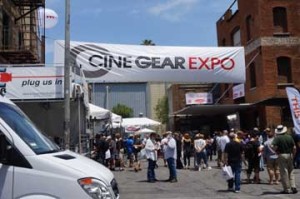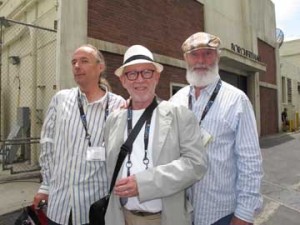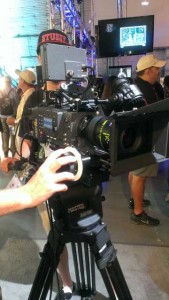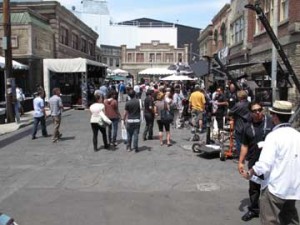
The 16th annual Cine Gear Expo was bigger than ever this year. More than 12,500 attendees, (up from 11,000 the year before) flocked to the southern half of the Paramount Studios backlot, a hospitable environment in the heart of Hollywood. Nothing much new was unveiled – the debut of new camera gear took place in April at the National Association of Broadcasters show in Las Vegas. But Cine Gear, the first major show after NAB, pitches to the world’s most prestigious and discerning crowd – the community of Los Angeles-based cinematographers and their crews.
Camera support equipment, (including lots of new quadrocopters and flying support platforms), accessories and lighting were the main themes, along with the transformative role of digital technology on everything from image capture to all aspects of postproduction.
While the digital tsunami has been disruptive, it has also been embraced by the town’s cinematographers. This view was capsulized by Steven Poster, who was recently re-elected president of the International Cinematographers Guild, IATSE local 600. He told an ICG panel that old trade-offs between speed, cost and quality are disappearing with the advent of new digital tools and workflows.
“We are now at a unique moment where you can have all three. We can do it faster, cheaper and better,” he said. “The tools have taken leaps forward. Processing power and software have risen to the point where we can do it on set and save money, and let the director of photography [continue in the traditional role of keeper of the image.]”

Digital cameras were front and center at CineGear, but changes were evolutionary, not revolutionary. The emphasis was on anamorphic capture, the rise of 4K and the role of new chips and sensors. At Sony’s exhibit, the focus was on its top-of-the-line CineAlta F65 digital camera. First released in 2012, the latest version on display came with an 8K Super 35mm CMOS sensor (20.4 million pixels), double the 4K maximum currently available from competing manufacturers. “What it offers is an 8K sensor that oversamples for 4K, and 16-bit RAW recording,” explained Mike DesRoches, senior sales support engineer for Sony Electronics’ western region. “It’s the ultimate cinematographer’s tool. In the future, the camera will keep being upgraded to turn out 6K and then 8K, so you will be able to get those resolutions as they are required going forward.”
Though the camera is easy to use, according to the rep, “some wanting it to fail said when it came out that it was hard to deal with in post. The reality is the F65 can do things that allow a production to save a lot of time and money.” He cited its ability to “shoot in such a wide range of circumstances, whether you’re shooting interiors or exteriors, that lets you do things on set that used to require VFX fixes in postproduction.”
The camera’s capabilities were on display in two screenings of After Earth, the new Will Smith sci-fi film. Though the film is a critical and box-office failure, both screenings drew capacity crowds to the 500-seat Paramount Theater to view its production elements. With director of photography Peter Suschitzky doing the lensing, After Earth, is one of the first features photographed using Sony’s F65 and the first F65 feature finished in 4K. Oscar-winning cinematographer Claudio Miranda previously used the camera for Oblivion, the recent release starring Tom Cruise.
ARRI showed its popular Alexa digital camera, equipped with one of its new anamorphic lenses and a 4×3 35mm sensor. ARRI also had on display three of its new ARRI/ZEISS T1.9 Master Anamorphic lenses, which have just begun to ship, including 35mm, 50 mm and 75mm. The complete group of seven, ranging up to 135mm, will be rolled out during the remainder of this year through February 2014.

“Alexa is the only digital camera with true 4×3 anamorphic format, which we certainly see as a coming big trend with cinematographers,” said Franz Wieser, who works at ARRI’s Burbank facility. Other lens manufacturers also featured new lines of anamorphic lenses including Thales Angeniux, Cooke and Zeiss.
One of the more specialized cameras at CineGear was the FT-One, a super-slow-motion camera, manufactured by Tokyo-based For-A Company Limited. The camera is able to shoot in 4K at the astonishing speed of up to 900 frames per second. The frame rate is adjustable down to 60 fps. The prime market for the FT-One is sports broadcasting where it can repeat plays for viewers in super slo-mo and also for referees who have to review disputed calls. When paired with an Evertz Dreamcatcher, it’s possible to isolate a smaller part of the screen for an even closer look that retains resolution because of the 4K capture.
The NHL has made a commitment to use the FT-One in its upcoming Stanley Cup hockey finals. And CBS will be using two of the cameras for its NFL football broadcasts this fall. “We can do a replay in a second-and-a-half,” noted Chuck Bocan, western regional manager for the company which has its U.S. headquarters in Cypress, Calif. “In the future, many sports broadcasts are going to have one of these cameras in every location,” he predicted. The camera also is being used for commercials – a soon-to-be made ad for Mountain Dew will use an FT-One, and demand is expected to come from motion picture DP’s for special sequences.
Canon was featuring two new light-weight, ultra-compact camcorders, the XA20 and the XA25. Not yet available, they are designed as replacements for the XA10, aimed at consumers. The XA25 and XA20 feature a 20x zoom lens and built-in Dual Band, 2.4/5 GHz wi-fi and wireless FTP file transfer, which allow journalists working in remote locations to upload footage directly to a server in a broadcast studio. The price of the cameras is going to be around $3,200.

The streamlined cameras are “directed towards multimedia people who operate in a run-and-gun atmosphere, especially newsgathering professionals,” said Paul McAniff, professional market specialist for Canon based in Austin, Texas. “They can connect via wi-fi, and they can transfer their files to another computer.”
Also on display was the C500, the cutting edge camera at the top of Canon’s EOS series. Priced at around $25,000, the C500 is capable of capturing images in 4K and is designed for high-end shooting of major motion pictures in 2K and also HD television production. The C500’s capture is based on a 4K sensor developed by Canon for high frame-rate imaging. “The action is in the chips these days,” said McAniff.
Two special honors were handed out at CineGear. Triple Oscar-winner Haskell Wexler got the cinematography lifetime achievement award. His Academy Awards were for best cinematography in Who’s Afraid of Virginia Wolf? and Bound for Glory and for the documentary Interview With My Lai Veterans. The technical lifetime achievement award went to Cooke Optics Limited and Les Zellan.





